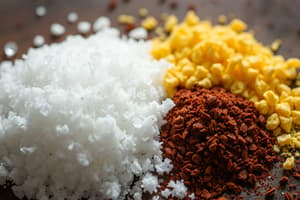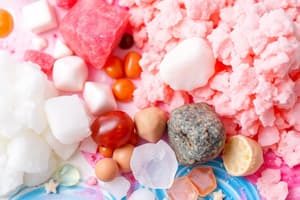Podcast
Questions and Answers
What is a pure substance?
What is a pure substance?
- A material that can be broken down by physical means
- A material consisting of only one type of particle (correct)
- A material containing two or more different types of particles
- A material that has variable properties
Which of the following examples is a compound?
Which of the following examples is a compound?
- Salt (correct)
- Copper
- Silver
- Gold
Which description best fits homogeneous mixtures?
Which description best fits homogeneous mixtures?
- Components are evenly distributed and uniform in composition (correct)
- Composition is non-uniform throughout
- Components can be distinctly identified
- Formed by combining multiple compounds
How can a compound be formed?
How can a compound be formed?
What distinguishes a solid from a liquid in terms of particle arrangement?
What distinguishes a solid from a liquid in terms of particle arrangement?
Which of the following is a characteristic of mixtures?
Which of the following is a characteristic of mixtures?
What type of matter consists of two or more elements that still retain their individual properties?
What type of matter consists of two or more elements that still retain their individual properties?
Which of the following is NOT true about elements?
Which of the following is NOT true about elements?
What is the primary characteristic of a heterogeneous mixture?
What is the primary characteristic of a heterogeneous mixture?
Which of the following best describes a suspension?
Which of the following best describes a suspension?
Which type of mixture do not separate upon standing?
Which type of mixture do not separate upon standing?
What distinguishes a colloid from a suspension?
What distinguishes a colloid from a suspension?
Which of the following is an example of a colloid?
Which of the following is an example of a colloid?
Which of the following mixtures is a suspension?
Which of the following mixtures is a suspension?
What is true about the components of heterogeneous mixtures?
What is true about the components of heterogeneous mixtures?
What is the defining feature of a homogeneous mixture?
What is the defining feature of a homogeneous mixture?
Study Notes
Classification of Matter
- Matter can be classified as either a pure substance or a mixture.
- Pure substances contain only one type of particle and have constant properties.
- Pure substances cannot be broken down by physical means.
Pure Substances
- Elements consist of a single type of atom; examples include gold, silver, and copper.
- Compounds are composed of two or more elements chemically combined; examples include sugar, salt, and baking soda.
Properties of Elements
- Elements cannot be broken down into simpler substances through chemical means.
- They represent the simplest form of matter and have properties consistent with a single type of particle.
States of Matter
- Solid: Particles are closely packed together.
- Liquid: Particles are in close contact but can move around each other.
- Gas: Particles are widely separated and move freely.
Compounds
- Formed when two or more elements combine chemically, resulting in a substance with unique properties.
Mixtures
- Comprised of two or more combined materials that retain their own properties.
- Mixtures can be either heterogeneous or homogeneous.
Homogeneous Mixtures
- Defined by a uniform composition where components are evenly distributed.
- Examples include:
- Salt dissolved in water
- Sugar dissolved in tea
- Air
- In homogeneous mixtures, the different parts are not visible, and the mixture appears consistent throughout.
Mixtures Overview
- A mixture consists of two or more substances combined together, yet they remain separable into their original components.
- Mixtures can be classified into two main types: homogeneous and heterogeneous.
Homogeneous vs. Heterogeneous Mixtures
- Homogeneous mixtures have a uniform composition throughout, meaning the individual components are not distinguishable.
- Heterogeneous mixtures possess varying composition, where the different components can be identified and separated.
Characteristics of Heterogeneous Mixtures
- Components within heterogeneous mixtures are typically large enough to be visually detectable.
- These mixtures are often easier to separate manually compared to homogeneous mixtures.
Types of Heterogeneous Mixtures
- Suspensions:
- Contain larger particles that can settle over time.
- Can be separated using filtration (e.g., muddy water, salad dressing).
- Colloids:
- Composed of smaller particles that remain evenly distributed and do not settle upon standing.
- Cannot be filtered (e.g., mayonnaise, milk, gelatin).
Types of Colloids
- Emulsion: A mixture of two immiscible liquids.
- Foam: Gas particles dispersed in a liquid or solid.
- Sol: Solid particles dispersed in a liquid.
- Gel: A semi-solid with a gel-like structure.
- Aerosol: Tiny solid or liquid particles dispersed in a gas.
Key Takeaways
- Mixtures can be categorized based on their properties and the behavior of their components.
- Both colloids and suspensions are types of heterogeneous mixtures but differ in particle size and behavior.
- Understanding the characteristics and differences among mixtures aids in their identification and separation.
Studying That Suits You
Use AI to generate personalized quizzes and flashcards to suit your learning preferences.
Description
This quiz explores the classification of matter into pure substances and mixtures. You will learn to identify characteristics of mixtures and differentiate them from pure substances. Prepare to test your understanding of fundamental concepts related to matter.




